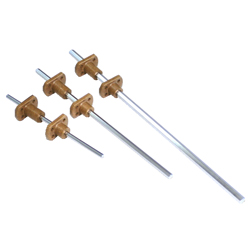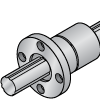(!)NOTE : Windows 7 users won’t be able to use some latest features of eCatalog/WOS since Microsoft is ending support for Windows 7 on 14 Jan, 2020. Please upgrade your system for uninterrupted services.
- Notice of End of Sales for Economy Series Pneumatic Equipment Category. More information.
OZAK Spline Shaft
|
Nut Type
|
|
|---|---|
Brand |
|
| CAD |
|
| Days to Ship |
|
1 items
- Sort By
-
You can add up to 6 items per a category to the compare list.

Miniature Hexagonal Spline, Single Nut (HTK) / Double Nut (HTKW) Series
OZAK
Miniature size (hexagonal axes 3, 4, 5) is standardized.[Features]・ It achieves downsizing and weight reduction of machinery・ The combination of resin nut (PPS resin) and stainless steel shaft (SUS304) has excellent corrosion resistance and can be used in a wide range of environments・ Non-backlash specifications (W Series) are also available as standard products
Nut Type Spline Shaft Outer Dia. D(Ø) Type Nut Length Nut Overall Length L1(mm) Nut Outer Dia. D1(Ø) Preload Accuracy Grade End Shape (Left) End Shape (Right) Torque Shaft material Number of Nuts(pc(s).) Flanged Type - Polygonal Standard 11.5 ~ 17.5 10 Standard Standard Grade Standard Standard Middle Torque SUS304 - Days to Ship: 11 Day(s) or more  11 Day(s) or more
11 Day(s) or more
Loading...
Configure
Specification/Dimensions
-
Spline Shaft Outer Dia. D(Ø)
-
Type
-
Nut Length
-
Nut Overall Length L1(mm)
-
Nut Outer Dia. D1(Ø)
-
Preload
-
Accuracy Grade
-
End Shape (Left)
-
 Standard
Standard -
 Tapped
Tapped -
 Stepped
Stepped -
 Stepped and Tapped
Stepped and Tapped -
 Stepped and Threaded
Stepped and Threaded
-
-
End Shape (Right)
-
 Standard
Standard -
 Tapped
Tapped -
 Stepped
Stepped -
 Stepped and Tapped
Stepped and Tapped -
 Stepped and Threaded
Stepped and Threaded
-
-
Torque
-
Shaft material
-
Number of Nuts(pc(s).)
Narrow search by specifying Manufacturer
Related Categories to Spline Shaft
FAQ Spline Shaft
- Question: What are spline shafts and their primary function in linear motion?
- Answer: Spline shafts are cylindrical rods with ridges or teeth along their length, known as splines. Their primary function in linear motion is to convert rotational motion into smooth and precise linear movement. These splines engage with complementary components to transmit torque efficiently, ensuring controlled motion without slipping or backlash. Spline shafts are crucial in various machinery applications where accurate linear motion is required, such as moving heavy loads or guiding tools with precision, providing reliable and efficient motion control.
- Question: Can you explain the key characteristics of square splines?
- Answer: Square splines feature square-shaped ridges and slots, offering efficient torque transmission and precise alignment. Their design allows for high torque capacity and compatibility with various mating components. Due to their simplicity of manufacture, they are cost-effective for many applications. Additionally, the even distribution of wear along the mating surfaces enhances durability. Square splines are widely used in industrial and mechanical systems where accurate motion control and reliable torque transmission are essential.
- Question: What role do spline shafts play in automotive transmissions?
- Answer: Spline shafts are essential in automotive transmissions for transferring power from the engine to the wheels. They connect parts like the clutch and gears, ensuring smooth power transmission. By enabling the engine's rotational motion to move the wheels with precision, they allow the vehicle to accelerate, decelerate, and shift gears seamlessly. Essentially, spline shafts ensure that your car moves smoothly and efficiently, contributing to its overall performance and driving experience.
- Question: What factors should be considered when choosing a spline shaft?
- Answer: When selecting a spline shaft, it's important to consider factors like the application's torque, speed, and precision requirements. Choose a spline profile and dimensions that match mating components to ensure efficient power transmission. Material selection is key for strength and corrosion resistance. The surface finish impacts durability, while manufacturing methods and costs should be evaluated. Supplier reliability is also crucial. By carefully considering these factors, you can choose a spline shaft that meets your application's needs effectively, ensuring optimal performance and longevity.
- Question: What materials are commonly used for manufacturing spline shafts?
- Answer: Spline shafts are commonly made from materials like steel, aluminum, brass, bronze, titanium, and plastics. Steel offers strength and durability, while aluminum is lightweight. Brass and bronze provide corrosion resistance. Titanium is strong and corrosion-resistant, ideal for demanding environments. Plastics offer benefits like low friction and electrical insulation. The choice depends on factors such as strength, corrosion resistance, weight, and cost.
- Question: What are the maintenance requirements for spline shafts?
- Answer: Maintaining spline shafts involves regular checks for wear, damage, and corrosion. Keep them lubricated to reduce friction and ensure smooth operation. Clean them regularly to prevent dirt buildup. Properly align mating components to avoid unnecessary stress on the shafts. Promptly replace any worn or damaged shafts to prevent further issues. Protect spline shafts from harsh environments and store them correctly when not in use. Following these steps will help ensure the longevity and efficient performance of spline shafts in machinery and equipment.
- Question: How do nut types of influence spline shaft functionality?
- Answer: The type of nut used can significantly affect spline shaft functionality. Slotted nuts provide anti-rotation, ensuring the nut and shaft move together for enhanced torque transmission. Hex nuts offer stability with six sides but lack anti-rotation features. Lock nuts prevent unintentional loosening, employing mechanisms like nylon inserts or serrations. Flange nuts distribute load over a wider area with a built-in washer-like flange. Self-locking nuts have integrated locking features to prevent loosening due to vibrations or external forces. Each type suits specific applications based on torque requirements, environmental conditions, and space constraints.


















How can we improve?
How can we improve?
Thank you for your time.
Your feedback is essential for our continuous improvement
Privacy Policy
Thank you for your cooperation.
Thank you for your time.
Your feedback is essential for our continuous improvement
Please use the inquiry form.
Privacy Policy